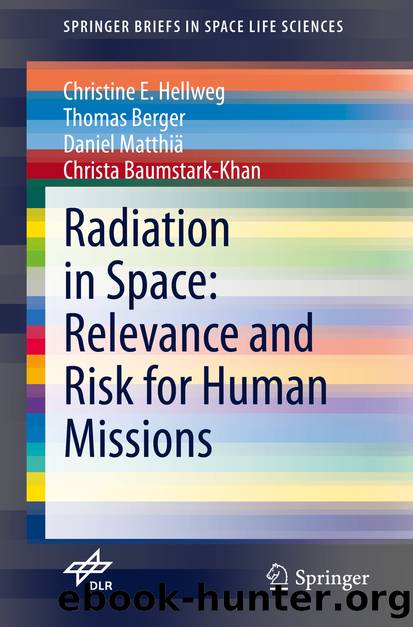Radiation in Space: Relevance and Risk for Human Missions by Christine E. Hellweg & Thomas Berger & Daniel Matthiä & Christa Baumstark-Khan

Author:Christine E. Hellweg & Thomas Berger & Daniel Matthiä & Christa Baumstark-Khan
Language: eng
Format: epub
ISBN: 9783030467449
Publisher: Springer International Publishing
3.2.5 Non-Targeted Effects
The responses of cells to radiation in the absence of direct DNA damage are designated as non-targeted effects (Prise et al. 2006). They usually follow a nonlinear dose–effect relationship and include bystander effects in which charged particle hit cells transmit signals to surrounding cells by direct contact (via gap junctions) or by secreting factors (Marin et al. 2015). Resulting changes the tissue microenvironment encompass oxidative damage (Mothersill and Seymour 2004, Rola et al. 2005, Sokolov et al. 2007), persistent inflammation (Kusunoki and Hayashi 2008), and extracellular matrix remodeling (Park et al. 2003, Durante and Cucinotta 2008). When irradiation of one tissue or organ affects responses in another unirradiated tissue or organ, these are called abscopal effects (Cucinotta et al. 2019).
Genomic instability is characterized by an increased rate of acquisition of alterations in the mammalian genome (chromosomal aberrations, aneuploidy, delayed lethal mutations, gene amplifications, micronuclei) in the progeny of irradiated cells (Hamada et al. 2008, Marin et al. 2015, Tang and Loke 2015). This phenomenon was observed, e.g., after high-LET α-particle exposure (Kadhim et al. 1992, Sabatier et al. 1992) and was explained by centrosome deregulation (Maxwell et al. 2008). While its role in radiation carcinogenesis was under debate (Huang et al. 2003, Sieber et al. 2003, Kadhim et al. 2006), recent results show the involvement of non-targeted effects in heavy ion-induced mammary carcinogenesis (Barcellos-Hoff and Mao 2016).
Adaptive responses represent another type of non-targeted effects. They were observed in various model systems after fractionated radiation exposure: a low priming dose (0.01–0.5 Gy) protects from effects of a subsequent higher dose (called challenging dose) which is explained by activation of protective pathways (Joiner et al. 2001, Schöllnberger et al. 2004, Tapio and Jacob 2007). A radiation-induced adaptive response can be maintained for a few hours to several months, as indicated by a reduction of cell death, chromosomal aberrations, mutations, and radiosensitivity or induction of DNA repair (Tapio and Jacob 2007). Low priming doses might result in one track per cell nucleus in average, meaning that part of the cells were untargeted (Tapio and Jacob 2007).
Another effect can occur after low-dose exposure: low-dose hypersensitivity which means that cells die extensively from exposure to a single low dose (<0.1 Gy) which cannot be extrapolated from the survival at higher doses (Tapio and Jacob 2007). It was explained as increased radiation sensitivity when DNA repair is not fully functional (Tapio and Jacob 2007).
The role of non-targeted effects in the in vivo radiation response, in the pathogenesis of radiation-induced diseases, in inter-individual radiation sensitivity and in radiation risk is difficult to assess (Morgan 2003, Prise et al. 2006, Kadhim et al. 2013).
Download
This site does not store any files on its server. We only index and link to content provided by other sites. Please contact the content providers to delete copyright contents if any and email us, we'll remove relevant links or contents immediately.
| Automotive | Engineering |
| Transportation |
Whiskies Galore by Ian Buxton(41529)
Introduction to Aircraft Design (Cambridge Aerospace Series) by John P. Fielding(32888)
Small Unmanned Fixed-wing Aircraft Design by Andrew J. Keane Andras Sobester James P. Scanlan & András Sóbester & James P. Scanlan(32573)
Craft Beer for the Homebrewer by Michael Agnew(17933)
Turbulence by E. J. Noyes(7700)
The Complete Stick Figure Physics Tutorials by Allen Sarah(7138)
Kaplan MCAT General Chemistry Review by Kaplan(6595)
The Thirst by Nesbo Jo(6435)
Bad Blood by John Carreyrou(6274)
Modelling of Convective Heat and Mass Transfer in Rotating Flows by Igor V. Shevchuk(6222)
Learning SQL by Alan Beaulieu(6035)
Weapons of Math Destruction by Cathy O'Neil(5829)
Man-made Catastrophes and Risk Information Concealment by Dmitry Chernov & Didier Sornette(5646)
Digital Minimalism by Cal Newport;(5389)
Life 3.0: Being Human in the Age of Artificial Intelligence by Tegmark Max(5184)
iGen by Jean M. Twenge(5161)
Secrets of Antigravity Propulsion: Tesla, UFOs, and Classified Aerospace Technology by Ph.D. Paul A. Laviolette(4990)
Design of Trajectory Optimization Approach for Space Maneuver Vehicle Skip Entry Problems by Runqi Chai & Al Savvaris & Antonios Tsourdos & Senchun Chai(4839)
Electronic Devices & Circuits by Jacob Millman & Christos C. Halkias(4748)
